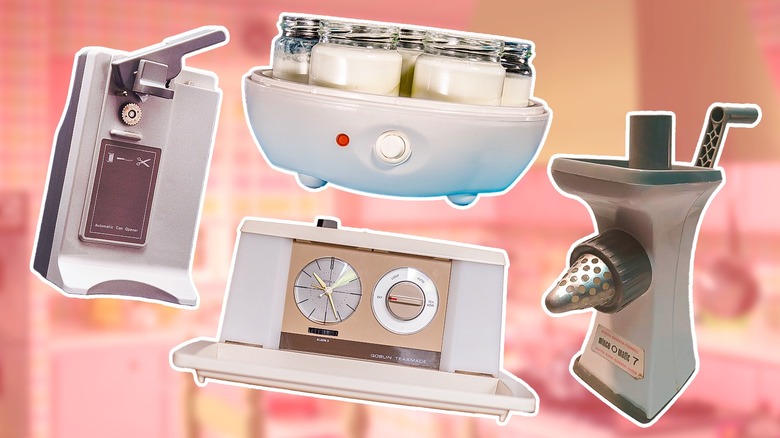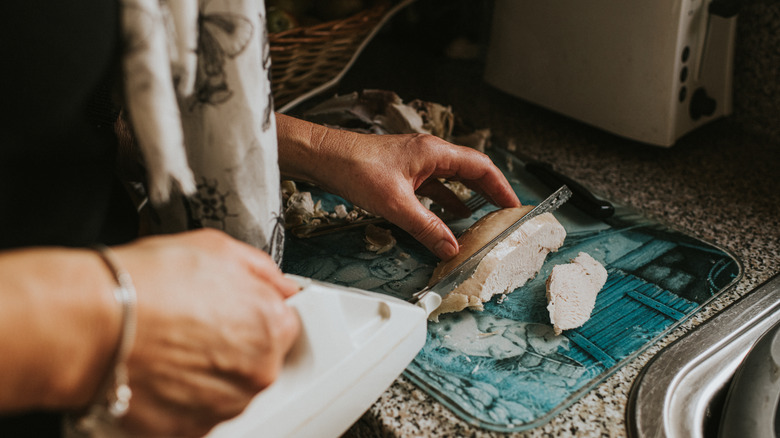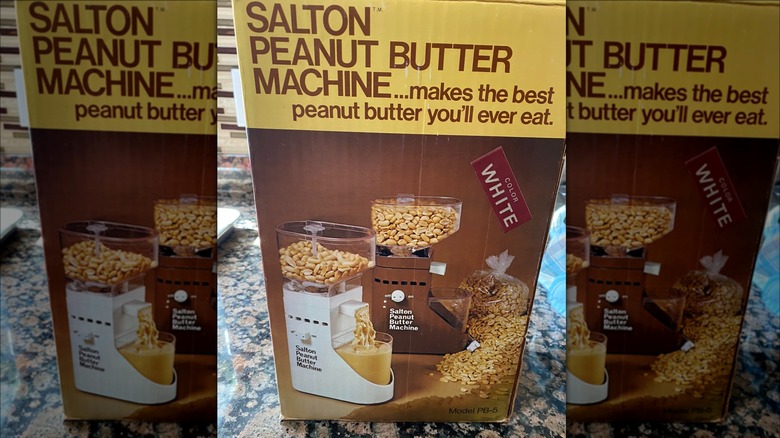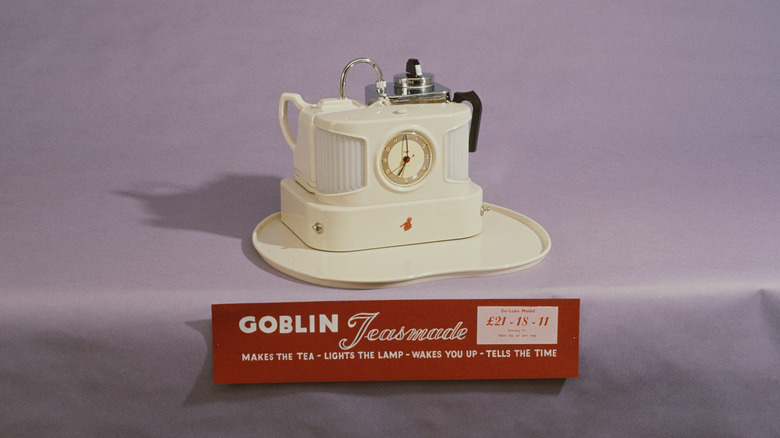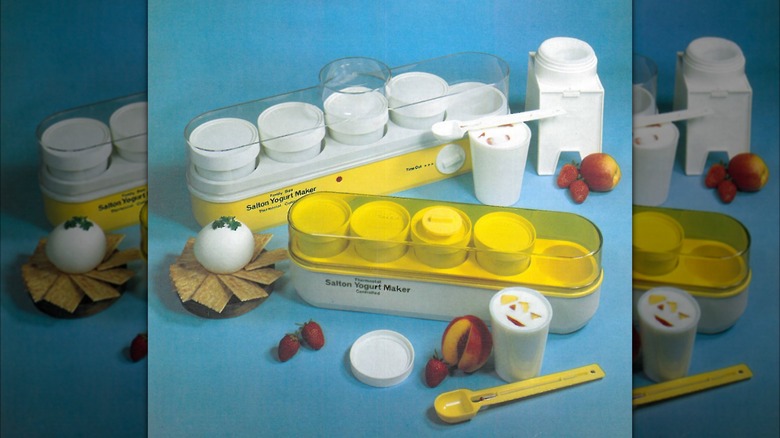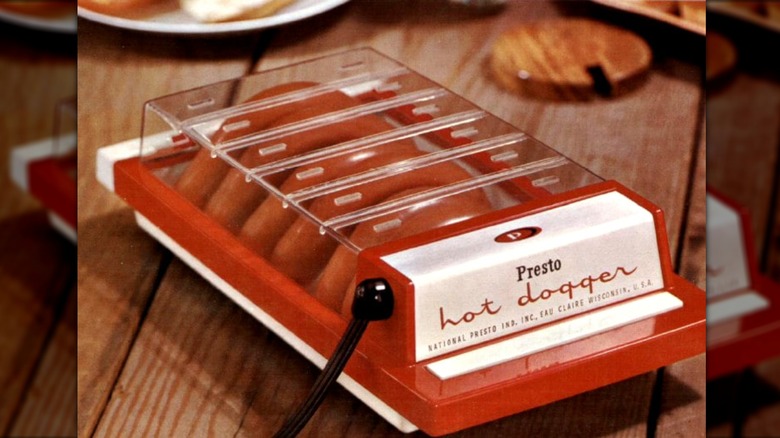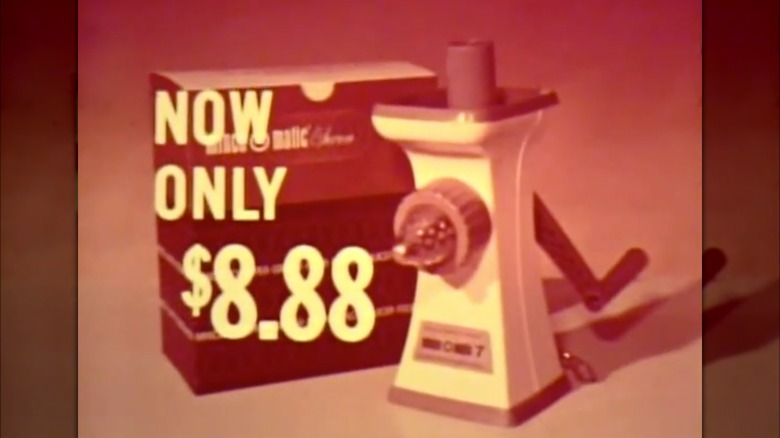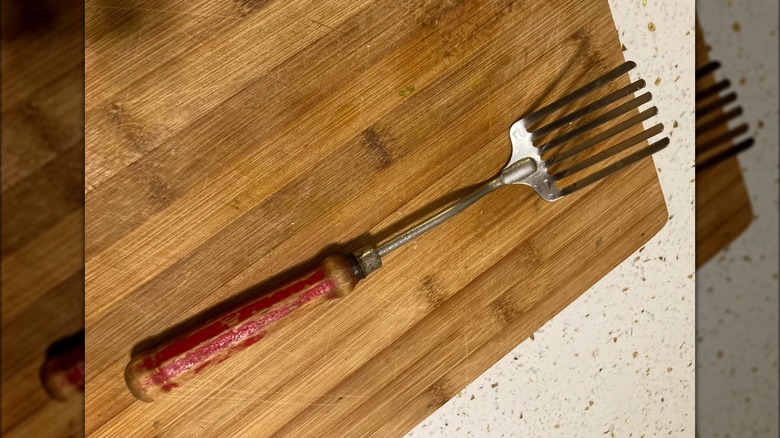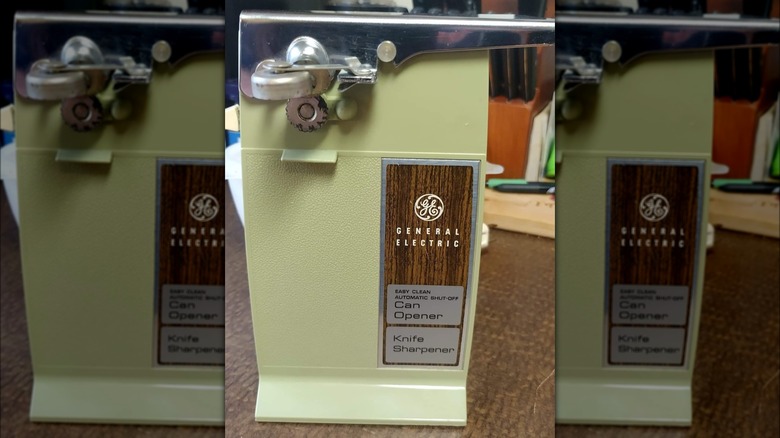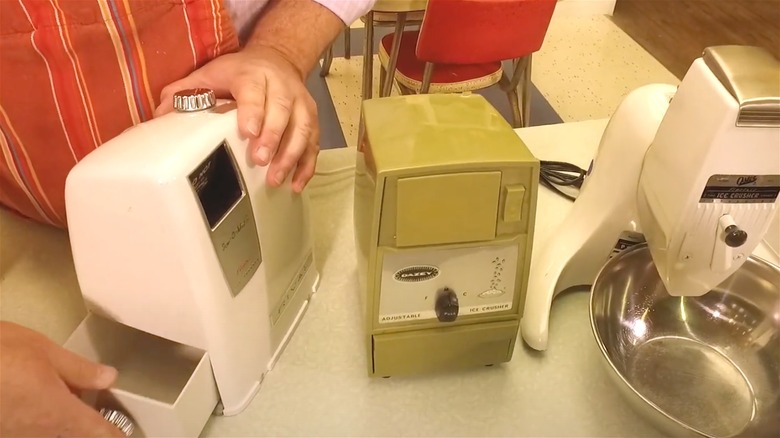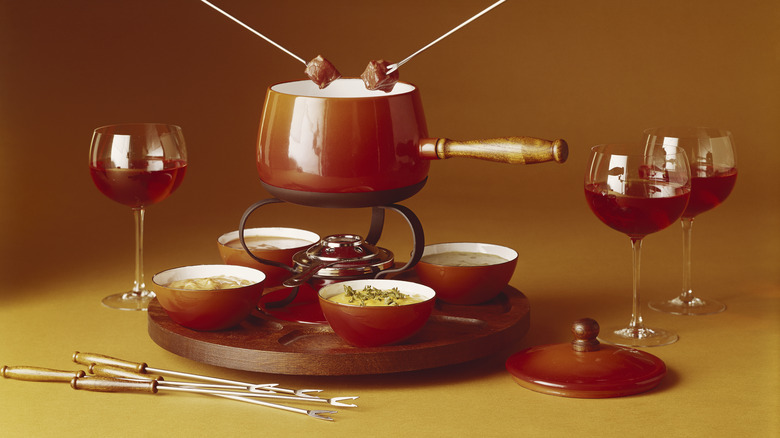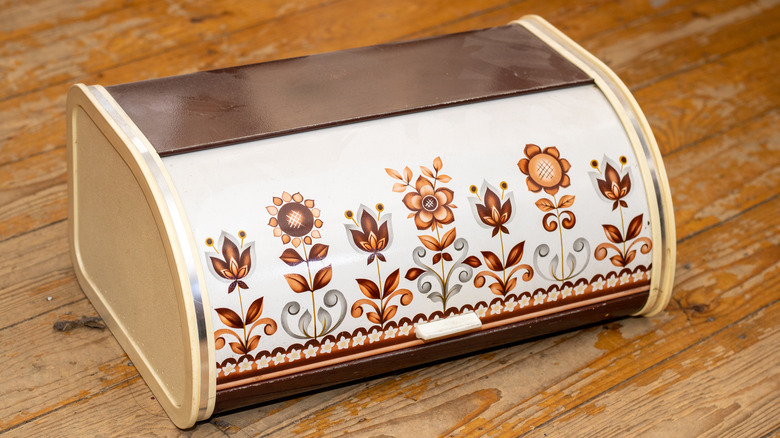Kitchen Tools That Were Popular 50 Years Ago But No One Uses Anymore
Just like with anything, kitchen trends come and go, leaving behind a trail of out-of-style and obsolete gadgets in their wake. Even 50 years ago, kitchens looked a lot different than they do now. Colorful patterned wallpaper, Formica countertops, and avocado green everything were all the rage back then. Kitchen tools and appliances also looked different, with some now nearly forgotten with the passing of time. If you were around during their peak popularity, these items might stir up a sense of nostalgia 一 or, you might still have one or two of them tucked away in the depths of your kitchen cabinets.
While some of these tools may seem ridiculous by today's standards, keep in mind that many of these inventions were once at the cutting edge of technology. Today, they're mainly appreciated by vintage collectors, historians, and niche hobbyists, though they may also be of interest to anyone curious about what life was like 50 years ago. These relics of the past offer a glimpse at how people used to cook, eat, and live, making them intriguing representations of a time now long gone.
Electric knives
If you've ever found the act of cutting meat with a knife tiring or tedious, the good news is that an electric version exists. The invention dates back to 1964, when the first electric carving knife was patented. This early version was powered by an electric motor and utilized two moving blades – but it wasn't until big brand names like General Electric and Black & Decker launched their own electric knives that the concept caught on. Thanks to these companies' advertising efforts, the electric knife became a highly popular and wished-for item among American consumers. By 1971, approximately one in three families in the U.S. had one.
The electric knife had its drawbacks, however. It was prone to tearing the meat, resulting in shredded, inconsistently sized cuts. The device's design was also unsanitary 一 grease and meat remnants could build up in the handle and in between the blades, making it a chore to properly clean. Perhaps most annoyingly of all, the knife's motor was ear-splittingly loud, letting your entire household (and your neighbors) know what was for dinner. It's no surprise that the electric knife's popularity waned over the years. Today, home chefs typically only use it to cut the Thanksgiving turkey.
Peanut butter machine
Like its name suggests, the peanut butter machine lets you make your own deliciously creamy nut butter from the comfort of your home. Unnecessary? Households in the 1970s didn't think so. The first ever peanut butter machine was actually a repurposed meat grinder, invented in the 19th century by Joseph Lambert, an employee at John Harvey Kellogg's health sanitorium. In the 1970s, electric versions were hitting the market, but restaurants and food production companies weren't the only audience 一 consumers were also adding the machine to their growing collection of home appliances.
One popular model by Salton featured a dial that let users customize the consistency of their peanut butter. Enthusiasts could pick their preferred texture, from smooth to chunky or somewhere in between. Operating the machine could not be more simple 一 simply dump in your nuts at the top and watch as perfectly spreadable peanut butter comes out the spout. While effective at making peanut butter, it's easy to see how this device might have fallen out of favor with the masses. Its niche application and bulky design likely made it a must-have item only for the most dedicated of peanut butter lovers.
Teasmade
This distinctly British device is an alarm clock that also boils and brews tea. Arising from a desire for automation in the home, it's the ideal invention for anyone who finds themselves too rushed in the morning to make a proper cuppa. Though the teasmade reached the height of its popularity in the '60s and '70s, the first models date back to the 1890s, relying on gas and a lit flame. In the 1930s, these (slightly dangerous) contraptions were laid to rest with the emergence of electricity in British households. This led to the creation of the teasmade as we know it today.
Perhaps the most popular model, the Goblin Teasmade, worked by boiling and transferring water to a teapot. This set off the alarm clock as well as lit up a built-in lamp. Some of the first versions of the product had clock faces that glowed in the dark thanks to radium paint, though this was phased out. One of the most iconic iterations of the Goblin Teasmade launched in the '60s, featuring a stylish faux-art deco design. The device remained highly in demand throughout the '70s but fell out of favor with the rising popularity of the espresso machine.
Yogurt maker
In the '60s and '70s, people were becoming more health conscious. In the U.S., this era saw an increasing demand for organic, unprocessed foods, as well as an uptick in fad diets. Inspired by European eating habits, Americans were consuming more yogurt than ever before. Fitting with this trend, yogurt makers gained popularity during the early '70s, giving consumers the ability to safely make yogurt at home. At a time when yogurt wasn't as readily available in grocery stores, these electric devices let enthusiasts whip up a week's supply of the stuff.
The Salton Yogurt Maker was one of the most common models you could find in U.S. households. The appliance included simple instructions and only required two ingredients: milk and yogurt starter or culture. This model remained highly popular through the '90s but fell out of use as stores everywhere started carrying more brands of yogurt. With so many types of yogurt now easily accessible, the general public lost interest in making its own batches.
The Hot Dogger
In the '60s and '70s, the houseware and appliance brand Presto launched several popular devices, including the iconic Hot Dogger. The appliance made some impressive claims 一 it promised to cook six hot dogs in only 60 seconds. All you had to do was skewer the hot dogs on the device's rather menacing-looking spikes and plug the cord into an outlet. With no on/off buttons, the device had to be unplugged when the 60 seconds were up.
While the idea of cooking hot dogs by electrocuting them sounds a little odd (and risky), the Hot Dogger lived up to its claims. However, the appliance had quite limited functionality, as it could only handle hot dogs, and no other foods. Plus, its lack of buttons or an automatic shut-down capability made it potentially hazardous to operate. After all, the last thing you want when prepping a quick lunch is having to worry about getting electrocuted. Perhaps it's for the best that the Hot Dogger never left the '70s and today remains a novelty artifact of a bygone era.
The Mince-O-Matic
Today, K-tel is best known as a record label, but the company has roots in the kitchenware and appliances industry. In the '70s and '80s, you couldn't turn on the TV without being bombarded with one K-tel infomercial or another, hawking fascinating and innovative inventions such as the Veg-O-Matic, Chop-O-Matic, or the Mince-O-Matic. Philip Kives, the company founder, is credited with starting the now-infamous phrase, "But wait, there's more!" in his product commercials.
While new and improved iterations of the K-tel's most popular products still populate store shelves today, the concept of a dedicated mincing machine has all but disappeared from the casual home cook's kitchen. The Mince-O-Matic required a bit of elbow grease to operate 一 it involved turning a crank by hand, though the device did supposedly feature an immovable vacuum base to make this more manageable. Commercials claimed the appliance could mince everything from eggs and meat to carrots, onions, potatoes, and more. They even showed the machine crushing ice fine enough to make snow cones. It's safe to say these appliances failed to convince consumers of their long-standing value, as K-tel filed for Chapter 11 bankruptcy in 1984.
Foley Fork
Unlike many of the gadgets featured on this list, the Foley Fork had many uses. It could mash guacamole and potatoes, beat eggs, and mix, stir, and whisk just about anything else. Bakers also found it useful for cutting fat like butter or lard into flour. What set the Foley Fork 一 or the Granny Fork, as many call it nowadays 一 apart from other popular mid-century tools was its simple, effective design. A large metal utensil with six uneven tines, the Foley Fork was a practical kitchen essential. Among the fork's admirers was none other than Julia Child, who used one on her show, "The French Chef."
Unluckily for fans of the blending tool, Foley Manufacturing Co., the company behind the fork, merged with Belsaw Machinery in 1982. This move put a definitive end to Foley's line of kitchen tools. Today, there are several replicas available from modern kitchenware brands; however, the tool no longer is as popular or well-known as it once was. If any long-forgotten tool deserves a comeback, it's the Foley Fork for its versatility.
The electric can opener and knife sharpener
Though batches of new appliances were coming out in the '70s, counter space remained limited. Perhaps this was partly behind the drive to create gadgets that could multitask. One such invention was the combination electric can opener and knife sharpener. This two-in-one appliance promised to open cans and sharpen knives with ease, without the need for any manpower. Electric can openers had been around since the '30s, but it wasn't until 1956 that the brand Udico developed a free-standing machine 一 and it also had the dual ability to sharpen knives.
Other popular models came from brands such as General Electric and Dazey, which both offered the appliance in avocado green, the defining color of the '70s. While the gadget was popular for many years, it was still bulky and space-consuming. To make matters worse, it often performed below users' standards, especially when it came to sharpening knives. Today, can openers and knife sharpeners still have their place in many American households, but they've fortunately gone their separate ways.
Electric ice crusher
Before electric ice crushers gained popularity in the '60s, ice crushing machines were powered by manually cranking a handle to break down the ice. Thankfully, electricity made the job a whole lot easier. Electric ice crushers meant anyone could enjoy crushed ice in their glass with the push of a button. Many of these appliances even featured dials that allowed users to choose between fine and coarse ice textures, taking the art of cocktail making to the next level.
However, one downside to the appliance was its limited function 一 it only crushed ice. Users still had to make the ice using a tray in the freezer or a separate ice maker. Plus, refrigerator companies were increasingly incorporating more technology into their appliances. Today, many fridges can make, dispense, and crush ice, all in one appliance. While a small but dedicated group of enthusiasts still collect and use vintage ice crushers, the device's heyday has largely passed.
Fondue pots
Fondue was perhaps the most iconic food trend from 50 years ago. While associated with Swiss cuisine, fondue actually originates from Savoie, a region in the French Alps. The dish typically consists of a pot containing melted cheese, chocolate, oil, or broth. Partakers stick bite-size pieces of bread, meat, vegetables, or any other food (the options are truly limitless) on long forks, then dip them in the fondue pot's contents. While initially a food made by peasants to survive the long, cold winters, fondue captured Americans' hearts when it was introduced in the '60s.
Fondue pots remained a must-have appliance in American homes well into the '70s. These colorful pots were typically electric, though others were warmed by candles or alcohol burners. Prepping a fondue dinner was relatively simple and inexpensive, making it a popular choice for themed parties. By the mid 1970s, the fondue craze began dying down, though it saw a comeback in the 1990s and early 2000s. Today, fondue pots are no longer an essential appliance in most households, but perhaps they're due for another resurgence.
Decorated kitchenware
In the 1970s, bold patterns and decor were in style, decorating every corner of the home, including the kitchen. You may be familiar with the patterned linoleum floors and vibrant wallpapers, but this flair for maximalism also extended to kitchenware. Cookware, canisters, dishes, and even appliances were adorned with painted designs, often featuring nature-inspired themes like fruits, vegetables, flowers, and mushrooms.
In the '70s and '80s, Sears launched more than 250 kitchen products centered around the mushroom motif alone. These included themed pitchers, tea kettles, and cookie jars, but also more unexpected items like bacon racks, cutting boards, and can openers, all embellished with mushrooms. By the 2010s, decorated kitchenware had fallen to the wayside, while minimalism took over as the new reigning king of style. Today, however, some fans of kitsch actively seek out these vintage items in thrift stores and estate sales, hoping to reintroduce a little touch of '70s character into their homes. Despite these collectors' efforts and the resurgence of maximalism in the 2020s, it seems that nature-themed kitchenware has largely lost its appeal with the average consumer.
